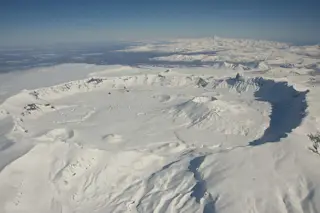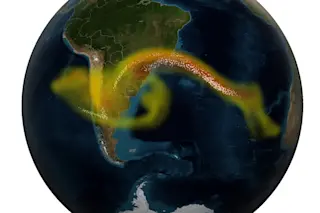The United States is a volcanic country. Sure, a large swath of it east of the Rocky Mountains haven’t had an eruptions of tens to hundreds of millions years, but the western US, Alaska and Hawai’i are all full of active or potentially active volcanoes. This got me wondering what are the biggest eruptions the US has experienced and that led me down a rabbit hole considering what that question actually means.
So, I present you with the largest eruptions in the US over the last 10,000 years. As you will see, this can be a tricky question. To try to normalize thing, I considered “biggest” to mean largest volume of erupted material, the higher eruption magnitude and then the eruption’s volcanic explosivity index (VEI; in the at order). I used the Smithsonian Institution Global Volcanism Program and the Volcano Global Risk Identification and Analysis Project (VOGRIPA) databases for my information.
A few things about measuring volcanic eruptions. First, explosive volcanic eruptions produce tephra, with is a bit of a catch-all for volcanic debris like ash, pumice, bombs, etc. Material like that tends to be full of air pockets, so to put all eruptions on an even playing field as the amount of air can vary, we convert it to a “dense rock equivalent” or DRE. This is a calculation using data about the percent of air in the deposit that then removes the volume of air to get at how much magma was actually erupted. All the volumes here are DRE.
Second, I’m leaning into using eruption magnitude over VEI. Unlike VEI, which uses volume of tephra to rank eruptions, eruption magnitude uses the log of the mass of the erupted material (log10(erupted mass in kg) − 7), thus discounting the amount of air in all the deposits. So, this makes a comparison that is a little more apples to apples and as you’ll see on the list, the VEI and eruption magnitude don’t differ too much.
Onto the list!
In Holocene (last ~11,000 years)
Why Holocene? Well, it roughly coincides with the arrival of humans to North America (although that is a moving target ... people likely arrived in the Americas as early as 30,000 years ago), so it seemed like a good place to start. (Just a quick note: 1 cubic kilometer is about 0.24 cubic miles ... what is about the same as 1,000 Houston Astrodomes).
1. Mazama (Crater Lake): VEI 7, mag 7.1, 5680 BCE, 50 cubic kilometers

A view of the Crater Lake from the Watchman Lookout Tower. Credit: Athleticamps, Wikimedia Commons.
Athleticamps, Wikimedia Commons.
The big one … and the only one in the top 10 outside Alaska. Oregon’s Crater Lake (called Mazama when discussing it before there was a lake) was formed in this cataclysmic eruption, likely close to the largest, if not the largest, on record in the modern Cascade (The Rockland Tephra from the Lassen Volcanic Center was also ~30-50 cubic kilometers). It is hard for me to fathom what the impact of such an eruption would be if it happened today in the Cascade Range.
2. Okmok: VEI 6, mag 6.7, 100 BCE, 29 cubic kilometers
Now we start our tour of Alaskan volcanoes. Most on this list are in the Aleutians, although a pair are found further east in the Wrangell Range. Okmok’s eruption in 100 BCE leads the pack. Okmok has always looked to me a lot like a drained Crater Lake and that’s because it too was formed by a massive eruption that prompted a collapse of the volcano. Unlike Crater Lake, the 100 BCE collapse was the second for Okmok, following one that occurred ~12,000 years ago. Also, unlike Crater Lake, Okmok has erupted in the 21st century – a VEI 4 eruption in 2008-09.
3. Aniakchak: VEI 6, mag 6.5, 1645 BCE, 27 cubic kilometers
Another big caldera-forming eruption, the 1645 BCE eruption of Aniakchak produced pyroclastic flows that ran 50 kilometers out from the volcano. It is also the most active volcano in the Aleutians with dozens of eruptions in the Holocene. We’re approaching the 100th anniversary of its last confirmed eruption, a VEI 4 event in 1931.
4. Churchill: VEI 6, mag 6.7; 847 CE, 23 cubic kilometers
How do you lose an eruption this big? The source of the White River Ash eruptions (north and east lobes) was controversial for years, but at the start of the century, its source was finally tracked to Mt. Churchill in the Wrangell Range. This is not exactly a highly volcanic area, yet two of the most explosive eruptions of the Holocene came from the remote Churchill. This blast, only ~1200 years ago, was likely a very dramatic event for the people living in the Yukon during that period.
5. Veniaminof: VEI 6, mag 6.7, 750 BCE, 20 cubic kilometers
What’s that you say? Another Alaskan caldera? The 1750 BCE eruption formed the 8 by 11 kilometer caldera that is now filled with glaciers and snow. Veniaminof continues to be one of the most active Aleutian volcanoes of the 21st century, with nine bouts of eruptions, including some as recently as 2021.
6. Novarupta: VEI 6, mag 6.5, 1912 CE, 13.5 cubic kilometers

We have now reached the only eruption that occurred while the US was a country: Novarupta (sometimes incorrectly called Katmai) in 1912. This famous eruption occurred between a range of volcanoes including Katmai and Trident, the former of which collapsed because of the eruption. The pyroclastic flow deposits created the Valley of 10,000 Smokes named for the fumaroles (gas vents) formed as the flows cooled.
7. Black Peak: VEI 6, mag 6.5, 1900 BCE, 12 cubic kilometers
This Alaskan volcano is tied with Aniakchak for #7. I have to admit, I wasn’t too familiar with Black Peak but it is another composite volcano in the Aleutians that has experienced caldera-forming eruptions. This eruption in ~1900 BCE filled the valleys around the volcano with upwards of 100 meters of ash and volcanic debris. Since then, there hasn’t been a recorded eruption from this volcano on the Alaska Peninsula
7. Aniakchak: VEI 6, mag 6.5, 6300 BCE, 12 cubic kilometers
Aniakchak’s second showing on the list, just a little smaller than the 1645 BCE eruption.
9. Churchill: VEI 6, mag 6.2, 60 CE, 4 cubic kilometers
And Churchill again … still big, but only ~ 1/5 the volume of the 847 CE blast.
10. Fisher: VEI 6, mag 6.2, 7420 BCE, 5.5 cubic kilometers
Stop me if you’ve heard this one before … but Fisher is a volcano on Unimak Island in the Aleutians that had a caldera-forming eruption. The caldera on Fisher is big, a good 11 by 18 kilometers across. Activity at Fisher since then has been at Mount Finch, a volcanic cone inside the caldera, as recently as the 1820s-30s.
It turns out, #11 and 12 are not in Alaska. St. Helens (6, 6, 1860 BCE, 4 cubic kilometers) in Washington and a precursor to the #1 eruption, Llao Rock at Mazama (6, 6, 5900 BCE, >2 cubic kilometers) just miss.
What about since the founding of US (so, last 247 years)
If we’re talking “in US history”, we likely need the US to exist … although some of these occurred before the area became part of the US. That’s OK in my books.
1. Novarupta: VEI 6, mag 6.5, 1912, 13.5 cubic kilometers
You heard about this before.
2. St. Helens: VEI 5, mag 5, 1800, 0.4 cubic kilometers
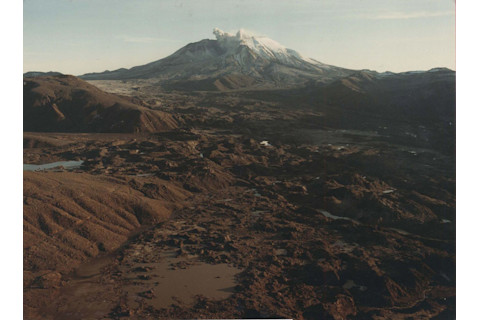
The hummocky terrane leading away from Mount St. Helens after the May 19, 1980 eruption. Much of the north side of the volcano slid away during a massive landslide seconds after an earthquake and before the eruption. US National Archives.
The only entry on this list not in Alaska or the Pacific Ocean, Mount St. Helens had two significant blasts since the signing of the Declaration of Independence. The 1800 eruption is slightly large in magnitude than the one coming up at #4.
2. Westdahl, VEI 4, mag 5, 1795, 0.4 cubic kilometers
Another Aleutian volcano. Although the 1795 eruption was bigger, it did experience a fissure eruption in 1991.
4. St. Helens, VEI 5, mag 4.8, 1980, 0.4 cubic kilometers
Likely the most famous eruption in American history, the 1980 Mount St. Helens eruption is small compared to many of the blasts on this list. However, it did give birth to much of the modern volcano monitoring in the US today.
5. Pavlof, VEI 4, mag 4.7, 1762, 0.22 cubic kilometers
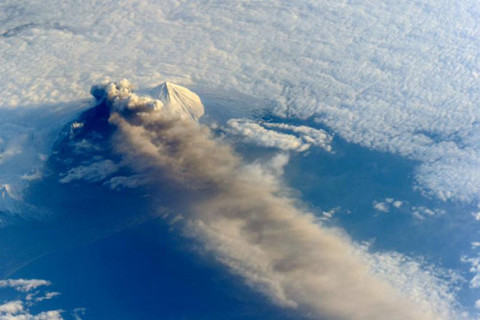
Beautiful, conical twin volcano (with Pavlof’s Sister) … in the Aleutians. It has been highly active since 2007.
6. Augustine, VEI 4, mag 4.7, 1976, 0.21 cubic kilometers
All alone on an island in the Cook Inlet of Alaska, Augustine is notorious for debris avalanches into the Inlet.
7. Pagan, VEI 4, mag 4.7, 1981, 0.20 cubic kilometers
Maybe this is cheating, but Pagan is in the Northern Mariana Islands of the Pacific, which is technically a territory of the United States. It is a complicated volcano with a caldera, but the 1981 eruption was quite large compared to most of its recent activity.
8. Aniakchak, VEI 4, mag 4.6, 1931, 0.4 cubic kilometers
We talked about Aniakchak above, but its last eruption in 1931 ranks high.
9. Augustine, VEI 4, mag 4.3, 1883, 0.09 cubic kilometers
Augustine, again.
10. Spurr, VEI 4, mag 4.3, 1953, >0.04 cubic kilometers
Spurr sits due west across the Cook Inlet from Anchorage. So, eruptions from this Alaskan volcano could be quite disruptive to air travel in and out of the busy cargo hub in Anchorage. It’s 1992 eruption, which was slightly smaller than the 1953 blast, caused one of the closest-to-a-disaster moments when a 747 passed through the ash cloud from the volcano.
Actual Eruptions in 50 states (after they were officially states)
If you’re still not happy with that list, what about a top 10 of eruptions from volcano that were officially part of the US when the eruption happened? Some of these eruptions begin to get a bit smaller, down to VEI 3, which are relatively common each year around the world.
1. Novarupta
2. Mount St. Helens
We talked about these two above.

4. Spurr 1992
5. Okmok 2008
6. Augustine 1986
7. Redoubt 2009
8. Cleveland 2006
9. Augustine 2005
10. Cleveland 2001
Everybody else is an eruption from one of the aforementioned Alaskan volcano except Kasatochi, which is also Alaskan but waaaay out in the distant Pacific Aleutians. It hasn’t had a large enough eruption in the Holocene to crack the other lists.
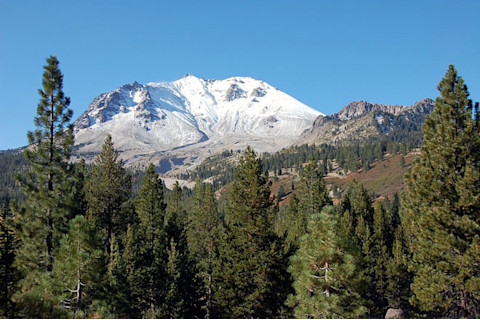
Finally, what is we don’t count Alaska? Well, the only two significant eruptions outside Alaska and Mount St. Helens that happened since the US was founded and the location in question was a state are as follows. The 1983-2018 eruption at Kīlauea tops this list, but it was a long, effusive eruption rather than an explosive event. Instead, we have to turn our attention to California and the 1914-1917 eruptions at Lassen Peak (Kohm Yah-mah-nee). That eruption threw out a paltry 0.007 cubic kilometers of volcanic debris. Compare that to the 50 cubic kilometers of Mazama/Crater Lake or even the 4 cubic kilometers of Mount St. Helens 1980.
All in all, this shows how little in the way of large volcanic eruptions this country has faced in its territory over the last 247 years. Now, the founding fathers likely never considered volcanoes as something the nation could contend with, but the reality is that we have a lot of volcanoes that could potentially land on these lists. Preparedness and research are the key to making sure we don’t end up with a massive disaster on our hands when they do erupt again.


